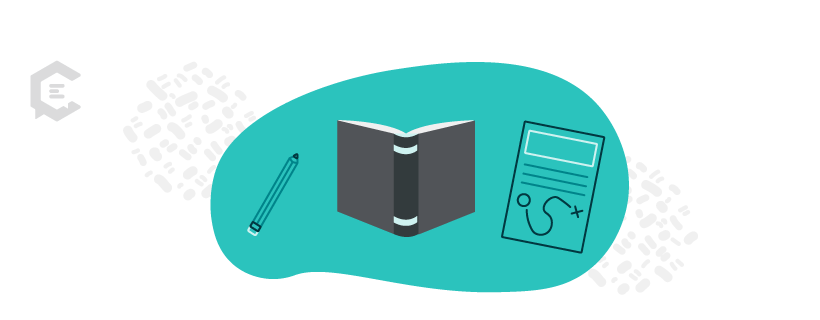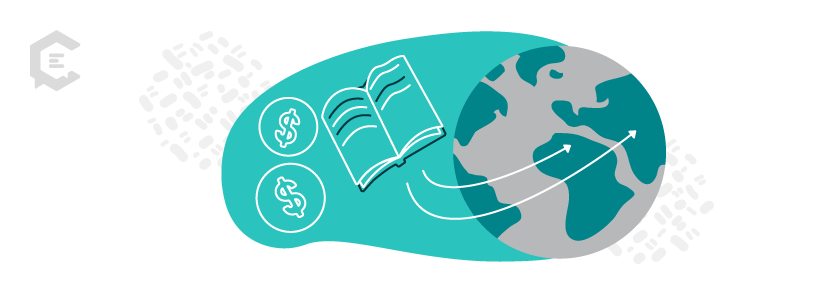Publishing a book of any format is a significant accomplishment. It’s one thing to have the idea or goal to write a book, but to actually execute that concept requires an entirely different level of discipline.
If you want to learn how to write an ebook, here are 10 clear steps to help you make it a reality with less stress and more clarity.

How to write an ebook in 10 steps
Writing an ebook has many benefits — it helps establish you as a thought leader in your industry, boosts trust and credibility, and can be an evergreen resource that adds immense value to your target audience.
Heck — you can even monetize it if you want to. With all of these benefits, you’re probably more than ready to learn how to write an ebook your ideal customer will love. So, let’s get started!
1. Begin with strategy.
It’s exciting to think of yourself as a published author. However, as a freelance professional or business owner, you should first begin with a creative brief for your ebook and a strategic plan.
For example, if you specialize in the financing and tax industry, consider the topics that create the most stress or tension for your audience and make your ebook focus on solving the problems your audience may encounter continually. Beginning with this outlook can assist you with creating a clear direction for your marketing strategy.
Many people begin the marketing process after completing the book, but you should have your plan before you start. We will discuss this later, but marketing execution should not happen simultaneously with formulating your marketing plan.
Create your initial strategy and get as detailed as possible with your KPIs, marketing channels, email marketing campaign, social media messaging, and all other marketing mediums you plan to help your ebook have and maintain success.
2. Reserve your ISBN.
This step is often overlooked when learning how to write an ebook, but it’s an important one.
Before diving into your options of an ISBN, we should first discuss what an ISBN is. According to Editiage, an ISBN (International Standard Book Number) is a 13-digit numeric code that serves as an internationally applicable unique identifier for books.
The code captures information regarding the book’s publisher, title, language, edition, and version. Think of this as your book’s fingerprint because all ISBNs are unique to their assigned books.
If you’re reading this and your primary goal is to complete your first ebook, you may be wondering if an ISBN is necessary. Although some publishing experts will tell you that you can publish your ebook without going through the hassle of reserving an ISBN, this couldn’t be further from the truth.
The reality is that if you’re planning to have a formal distribution like Amazon or Kindle, you will need to have an ISBN, or the distribution platform will reserve one for you.
If they reserve an ISBN Number for you, what does that mean? If the distribution channel secures an ISBN for your ebook on your behalf, that essentially means that they own the ISBN instead of you.
That may not be a big deal for some, but holding the ISBN is a preference of ownership rights. If you were working with a traditional publisher, the publisher would reserve the ISBN, and the book’s identification number will be documented with the company, not the author. This is very common with traditional publishers like Hachette, HarperCollins, Macmillan, Penguin Random House, and Simon & Schuster.
3. Do your research.
Now that you have a marketing plan and strategy along with an ISBN for writing your ebook, it’s time to dive into the content and context of your ebook. Take time to research your sources that reinforce topics and key takeaways.
Identify gaps in your market you can fill through writing your ebook. In addition to discovering your market impact, it’s also essential to research ebooks similar to yours. This doesn’t have to be exclusive to similar content. You should consider the size of the ebooks, the pricing, and distribution channels.
Although we will address this later, your distribution channels will be where you sell, market, and promote your ebook, and your pricing matters greatly based on the platform.
4. Outline your ebook’s structure.
Outlining your ebook’s structure is a very tactical step that can help guide your thoughts during the writing process. Instead of thinking of these areas as chapters, ponder on them as guiding writing pillars.
Here’s how to write an ebook with an outline:
- Introduction: I tend to write this section last. Once I write my publication, I then review it and create a holistic introduction that prepares the reader for their reading journey.
- Foundation: Beginning with the basics is always a great thing. Please don’t assume that your readers know the basic definitions or core principles for our ebook’s topic. Go through the core basics with you.
- Substance: Your substance within your ebook is your secret sauce. This section of your book is where you can showcase your expertise and the reason your ebook can be listed on an Amazon Bestseller list. Put your best foot forward to inspire, educate, and entertain.
- Resources: Share great resources to keep readers’ learning going. With ebooks, you can include hyperlinks and indirectly promote other things. Planning to have traditional distribution? Direct promotions are highly discouraged in the publishing industry. I wouldn’t directly promote products, goods, or services, but you can direct readers to learn more about you and all you offer.
- Conclusion: As you finalize your thoughts, remember that your ebook will last beyond seasonal campaigns. So never promote. Instead, guide them to reach out to you. In your conclusion, wrap up your ebook with your closing remarks and let them know where they can find you or potentially work with you moving forward. Feel free to share your social media links (and hyperlink them).
5. Incorporate your writing into your daily schedule.
Aside from the physical act of writing your ebook, you must be intentional about your environment and your time allocation. Without your dedicated, deliberate approach to your process, distractions will come and take you off course. Our ClearVoice writer Nicki Escudero shared great tips to maintain your focus and productivity, including the advice from Author Brian Tracy’s book, “Eat Your Frog!”
One of those tips includes tackling your most difficult (or unappealing) tasks first. Carve out a few hours each day to write uninterrupted during your process. Early mornings before the busyness of your day are ideal for quiet time. If you’re not a morning person, try late nights when emails are quiet and have minimal client demands. The key is to remove distractions to focus on your goal, which is your ebook.
6. Hire a professional editor and proofreader.
As a professional writer and industry expert within my field, I am a huge advocate for having a team of professionals around me who can check my work to ensure accuracy and proper grammatical structure. The closer I am to the project or writing piece, the more this is necessary. Do not go through the process of writing your ebook without having a trusted editor and proofreader to review your drafted work. As the writer, you may overlook things that their unbiased brains will catch.
7. Design your ebook cover.
This step can move up in your process, but it must be completed once your ebook draft is complete. If you decide to create your ebook cover before beginning your writing process, it can become a part of your motivation to complete the project. For some writers, it’s extremely helpful, while for others, it’s irrelevant. Regardless of when you start your brainstorming, remember that your book cover is the book’s first impression. Most of your readers will decide to purchase your ebook based on your book cover design. Your ebook cover design should be eye-catching to stand out from the crowd.
8. Submit your work for copyright.
As a writer, you are naturally the owner and author of your work. However, in the unfortunate circumstances requiring you to prove that the work is yours, you must have your publication registered with copyright to request proper attribution or credit for the work.
What is a copyright?
According to Copyright.gov, a copyright is a type of intellectual property that protects original works of authorship as soon as an author fixes the work in a tangible form of expression. In copyright law, a creator can protect bodies of work that include photography, musical compositions, and books.
Is it a requirement to register a copyright for your ebook? No. Is it wise to copyright your ebook to protect the rights to your work? Yes.
To begin copyright registration, simply go to the Copyright.gov site and create an account. You can register all publications and approved art forms for official copyright protection through that account.

9. Find and secure your book distribution platform.
Now that you have your ebook written, proofed, and edited, it’s now time to get it to the world! There are many ways to distribute your ebook, so it’s good to go back to your strategy and core objectives to consider the best distribution channels. Here are some that are most common for ebook distribution:
Landing pages
An ebook landing page is an excellent tool for marketing exclusively to the book, outlining the purpose for the ebook and the core things that your reader will take away from purchasing your ebook. Your reader can buy and receive the downloadable ebook from the landing page automatically to their computer or email (and this process depends on how you set up your payment structure and action triggers within the user experience of the landing page).
An author’s website
An author’s website gives more depth to the ebook and its connection to you as the author. If you have other offerings, services, or products within your business, this would be an ideal solution to drive ebook readers to purchase other offerings beyond the ebook purchase.
Amazon and Kindle
If you plan to include your ebook on Amazon or Kindle, you must meet the various requirements and formatting specifications. Beyond basic requirements for Amazon or Kindle distribution, you’re also encouraged to price your book in a competitive manner. Before pricing your ebook, do research on ebooks within that genre similar to your topic. This will help you ensure that your ebook can have proper pricing that aligns with other ebooks that readers have as options.
10. Have fun with marketing your ebook.
Many would see the most challenging part as the entire process of creating an ebook, but it’s quite the contrary. The real work begins after all of the previous steps are complete. With your ebook now having a home for purchase, let the fun begin with your marketing strategy. This may be the most essential step, considering the return on your investment of time, effort, and expertise depends on the number of people who download and consume your ebook.
For your marketing strategy, consider including email marketing, digital advertising, press interviews, social media advertising, and an always-on approach within your marketing content moving forward.
Your ebook’s success depends on your marketing efforts that live well beyond your launch date. So, become very intentional about promoting your work, and get the word out regarding your new ebook!
Are you looking for help getting started with your upcoming ebook? Contact ClearVoice to learn how we can support you in making your ebook for your brand a reality!



